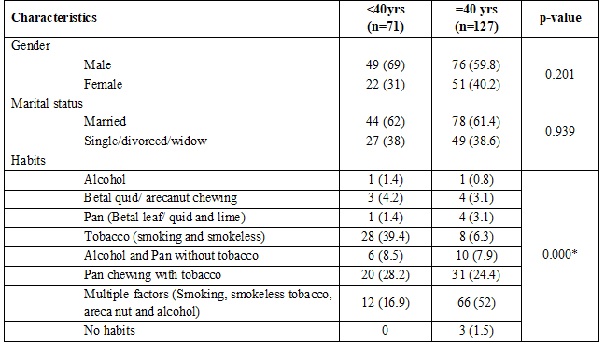A comparative analysis of demographic and aetiological features in young and old patients of buccal mucosa cancer
Abstract
Background: Oral squamous cell carcinoma (OSCC) most commonly occurs in the middle-aged and older individuals. It is believed thatrole of aetiologyisdifferent in young and old patients.
Objective: This study was conducted to analyse the comparisonof demographic and aetiological difference in young and old patients of buccal mucosa cancer.
Materials and Methods: In this retrospective study, demographicand aetiological details were retrieved form medical records between Mar. 2013 and Jan. 2016.
Results: The patients were grouped as younger (<40 years) and elder (aged 40 years and above). Of 198 patients, higherincidence was observed in older patients. Both younger and older groups showed male predominance (male: female ratio was 4:1 and 3.7:1 in younger and older groups, respectively).
Conclusion: The present study proved that young (<40 yrs) adults with OSCC showed aggressive course compared with elders (≥40 yrs).The aggressiveness of disease may be due to the presence ofrisk habits. However, further studies need to find the hidden risk factors for lower survival.
Downloads
References
2. Salian V, Dinakar C, Shetty P, Ajila V. Etiological trends in oral squamous cell carcinoma: A retrospective institutional study. Cancer Transl Med 2016;2(2):33-6.
3. Patil PB, Bathi R, Chaudhari S. Prevalence of oral mucosal lesions in dental patients with tobacco smoking, chewing, and mixed habits: A cross-sectional study in South India. J Family Community Med. 2013 May;20 (2):130-5. doi: 10.4103/2230-8229.114777.[pubmed]
4. Moyses RA, Lopez RV, Cury PM, Siqueira SA, Curioni OA, Gois Filho JF, et al. Significant differences in demographic, clinical, and pathological features in relation to smoking and alcohol consumption among 1,633 head and neck cancer patients. Clinics (Sao Paulo). 2013 Jun; 68(6): 738–744. doi: 10.6061/clinics/2013(06)03.
5. Chandra A, Singh A, Sebastian BT, et al. Oral squamous cell carcinomas in age distinct population: a comparison of p53 immunoexpression. J Cancer Res Ther. 2013 Oct-Dec;9(4):587-91. doi: 10.4103/0973-1482.126452.[pubmed]
6. Iype EM, Pandey M, Mathew A, et al. Oral cancer among patients under the age of 35 years. J Postgrad Med. 2001 Jul-Sep;47(3):171-6.[pubmed]
7. Santos HBP, dos Santos TKG, Paz AR, Cavalcanti YW, Nonaka CFW, Godoy GP, Alves PM. Clinical findings and risk factors to oral squamous cell carcinoma in young patients: A 12-year retrospective analysis. MedOral PatolOral Cir Bucal. 2016;21 (2): 151-56.
8. Soudry E, Preis M, Hod R, et al. Squamous cell carcinoma of the oral tongue in patients younger than 30 years: clinicopathologic features and outcome. Clin Otolaryngol. 2010 Aug;35(4):307-12. doi: 10.1111/j.1749-4486.2010.02164.x.[pubmed]
9. Troeltzsch M, Knösel T, Eichinger C, et al. Clinicopathologic features of oral squamous cell carcinoma: do they vary in different age groups? J Oral Maxillofac Surg. 2014 Jul;72(7):1291-300. doi: 10.1016/j.joms.2014. 01.009. Epub 2014 Jan 23.[pubmed]
10. Barnes L, Eveson JW, Reichart P, Sidransky O, Geneva: World Health Organisation Classification of Tumor. Pathology and genetics of head and neck tumors. WHO 2005: 168-75.
11. Beena VT, Binidree SS, Ayswarya T, PaikkadanI, Padmakumar SK, Sivakumar R. Oral squamous cell carcinoma in patients younger than 40 years: A 10 years retrospective study. Int J Sci Study 2016; 4(4): 150-53.
12. Sobin LH. TNM: evolution and relation to other prognostic factors. SeminSurg Oncol. 2003;21(1):3-7. DOI:10.1002/ssu.10014.[pubmed]
13. Padma R, Thilagavathi R, Sundaresan S. Survival outcomes of buccal mucosa carcinoma patients with multimodality therapy: An institutional study. Int J NutrPharmacol Neurol Dis 2016; 6: 76-80.
14. Gupta J, Gupta KK, Samadi FM, Kabiraj A. Smokeless tobacco and oral cancer: A review. Ind J Oral Sci 2012; 3(2): 74-78.
15. Muwonge R, Ramadas K, Sankila R, et al. Role of tobacco smoking, chewing and alcohol drinking in the risk of oral cancer in Trivandrum, India: a nested case-control design using incident cancer cases. Oral Oncol. 2008 May;44(5):446-54. Epub 2007 Oct 22.[pubmed]
16. Siriwardena BS, Tilakaratne A, Amaratunga EA, et al. Analysis of histopathological and immunohisto-chemical differences of oral squamous cell carcinoma in young and old patients in Sri Lanka. J Oral Pathol Med. 2007 Jul;36(6):357-62. DOI:10.1111/j.1600-0714.2007.00548.x.[pubmed]
17. Fang KH, Kao HK, Cheng MH, et al. Histological differentiation of primary oral squamous cell carcinomas in an area of betel quid chewing prevalence. Otolaryngol Head Neck Surg. 2009 Dec;141(6):743-9. doi: 10.1016/j.otohns.2009.09.012.[pubmed]
18. Iype EM, Pandey M, Mathew A, et al. Squamous cell cancer of the buccal mucosa in young adults. Br J Oral Maxillofac Surg. 2004 Jun;42(3):185-9.[pubmed]
19. Chang TS, Chang CM, Ho HC, et al. Impact of young age on the prognosis for oral cancer: a population-based study in Taiwan. PLoS One. 2013 Sep 26;8(9):e75855. doi: 10.1371/journal.pone.0075855. eCollection 2013.[pubmed]



 OAI - Open Archives Initiative
OAI - Open Archives Initiative


